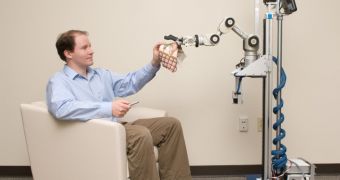Robots, as most other computer controlled devices, probably will never be able to fully understand human language, or to differentiate between two images of the same object. That is the disadvantage of processing information in binary code. However, robots can be taught, or at least instructed. Such a robot was recently created by Charlie Kemp, director of the Center for Healthcare Robotics in the Health Systems Institute at the Georgia Institute of Technology and Emory University.
With the help of a simple low-power laser pointer, the robot can be instructed to find and return a certain object. El-E, as the robot is named, can be commanded with the help of a green laser pointer. When one points the laser beam at a specific object within a room, El-E moves to the designated location, picks up the object and returns it to the person who gave the command.
Professor Julie Jacko of Georgia Tech and Emory research team believes that, one day, El-E will no longer be restricted to laboratory activities, but will be put into mass production to be used by patients with severe mobility challenges that require round the clock assistance.
Many times it has been proven that robots often confuse verbal commands. You might have noticed that with cellular phones that have voice command. For example, if you say "Call grandfather!" the telephone's voice processing unit might interpret the command as "Call father!". To make a clear difference between the two words, a robot must first have a good control of the human language, something which is unlikely to happen any time soon.
Change in strategy
"We humans naturally point at things but we aren't very accurate, so we use the context of the situation or verbal cues to clarify which object is important," said Kemp. Assistant professor Wallace H. Coulter says that "Robots have some ability to retrieve specific, predefined objects, such as a soda can, but retrieving generic everyday objects has been a challenge for robots."
The laser pointer method is one of the simplest ways to provide El-E with the specific information for it to understand and complete a task. Understanding what or how the respective object is called is secondary. El-E exploits the fact that, within the testing environment, most of the surfaces on which objects are found are mostly flat.
When given a command, El-E immediately implements a strategy to locate, grab and retrieve the object. First it moves in the close vicinity of the object, so that its arm is in the range to grab it, and after that it adjusts the height of the arm to match that of the object. Once this is done, El-E gently gets a hold of it and retrieves it to the person giving the command.
With the help of an omni-directional camera, the robot is able to obtain a panoramic image of the room, to spot and triangulate the location of the specific object in a three-dimensional environment. If required, the robot can also be commanded to deliver an object to another location of the room, also by laser control, all is needed is that it should make a difference between the two commands.
Making the difference
While retrieving the object to a person, El-E waits for a command input. If the laser command doesn't come then it starts looking for the presence of a human face inside the room. Once found, it executes the action it was programed with. In case it doesn't find the face, it will once again wait for a laser command input.
As the task is completed, it will return to the user's side and wait for further requests. Its creators say that El-E is completely autonomous, having the power supply and the computer systems on board, and runs on a Linus Ubuntu distribution.
"If you want a robot to cook a meal or brush your hair, you will probably want the robot to first fetch the items it will need, and for tasks such as cleaning up around the home, it is essential that the robot be able to pick up objects and move them to new locations. We see object fetching as a core capability for future robots in healthcare settings, such as the home," Kemp said.

 14 DAY TRIAL //
14 DAY TRIAL //